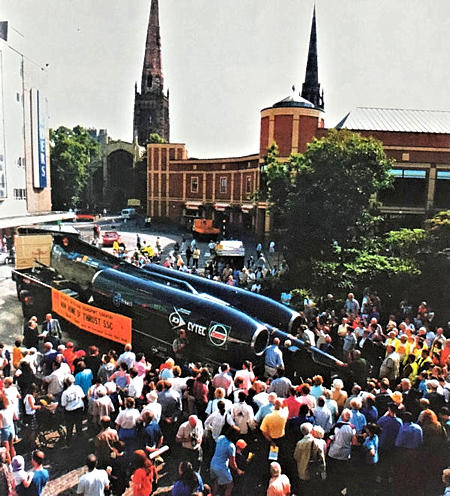|
Index...
|

 ichard Noble was keen to break the world land speed record. His first car, called Thrust, crashed and overturned, but his next car, Thrust 2, was better designed and more thoroughly tested.
ichard Noble was keen to break the world land speed record. His first car, called Thrust, crashed and overturned, but his next car, Thrust 2, was better designed and more thoroughly tested.
Thrust 2 broke the world land speed record in 1983 at the Black Rock Desert, USA, with a speed of 633 mph, driven by Richard Noble. Subsequently, the Thrust team decided that the car should be allowed to tour the UK to allow the public to get a close-up view of this historic car.
Chris Boyce, the Transport Museum's Development Officer, decided to contact the Thrust team to see if they would be willing to loan it to the Coventry Transport Museum. Not only did they agree to do so, but they agreed that the museum could be the home of the car whilst not on display anywhere else. The car was on the back of a low loader and it would be parked up in the large display area at the rear of the museum. Sometimes it would be taken out to attend race meetings or exhibitions.

In 1986 the Thrust team decided that the car would be placed on permanent loan to a museum, and they held a competition to decide which organisation could come up with the best proposition for displaying the car. Everyone assumed the car would join other former land speed record cars, such as Bluebird, the Golden Arrow, etc., which were then displayed at the National Motor Museum at Beaulieu. However, Chris Boyce, and I as the museum's Exhibition Officer, had other ideas, and proposed a multi-media, audio-visual exhibition. It was far and away the competition winner and Thrust 2 duly arrived on permanent loan.
The Thrust 2 auditorium was opened to great acclaim in 1987, and visitors regularly stood and applauded after seeing the audio-visual show called 'The Fastest Car on Earth', a brief history of land speed cars and the ups and down of the Thrust 2 attempts to break the record. It was a twelve-projector show with a short film project at the end of the final run. It would then go completely dark and Thrust 2 would appear from behind closed curtains with associated visual and audio support. With spinning spotlights, it gave the appearance that the car was speeding forward with a great rumble and roar.

This display continued for a number of years and, in 1992, the Thrust team decided to sell the car to raise funds for their ThrustSSC project. The museum, led by Barry Littlewood the Managing Director, immediately set about raising the purchase price. Through setting up a lottery, unique gifts were given to the museum, such as prizes like a go in Pete Waterman's Ferrari sports car around the Silverstone race track, and many other one-off prizes. This was years before the National Lottery was set up. We sold tickets throughout the year at many different events - including the NEC Motor Show, the Royal Show at the Stoneleigh Showground, and many more. We raised thousands of pounds, and this funding was matched by various grants from national funding bodies. Eventually the money was raised and Thrust 2 was purchased for the city in March 1993.
In 1997 ThrustSSC broke the world land speed record - this time driven by Wing Commander Andy Green, again at the Black Rock Desert in the USA, at a speed of 763 mph.

The relationship with the Thrust team was such that, with the engineering support of many local companies (so much so that the car is the only world land speed car to have the name of a city on its side, and carries the legend City of Coventry), that it was agreed it would go on a public tour of the city in December 1997. Such was the huge public reaction that there was a great clamour for ThrustSSC to be acquired by the City and join Thrust 2 at the museum. The museum staff accepted responsibility for raising funds and, thanks to massive support from the newly formed Heritage Lottery Fund, the purchase price was soon realised and ThrustSSC was acquired for the people of Coventry.

ThrustSSC was originally displayed in Broadgate on its arrival. The crowds were given 'MACH 1' Thunder Clappers to recreate the sonic boom. I had printed loads of comic type card and paper Clappers which had ThrustSSC on (see above). In the 'Mach 1 exhibition', denoting the fact that it was the first car in history to break the sound barrier, it was later to join Thrust 2 in the 'Spirit of Speed' exhibition opened in January 2003. The exhibition was a fully immersive audio-visual display that included a high-tech, sixteen-seater simulator where visitors could enjoy travelling inside the cockpit of ThrustSSC.
Today, the two fastest cars in history are displayed in a special area at the front of the museum for the enjoyment of visitors.
Paul Maddocks, 2022
Paul's next super Transport Museum article tells us about the 1987 F.A. Cup Winners' Sky Blue Bus.
Website by Rob Orland © 2002 to 2025